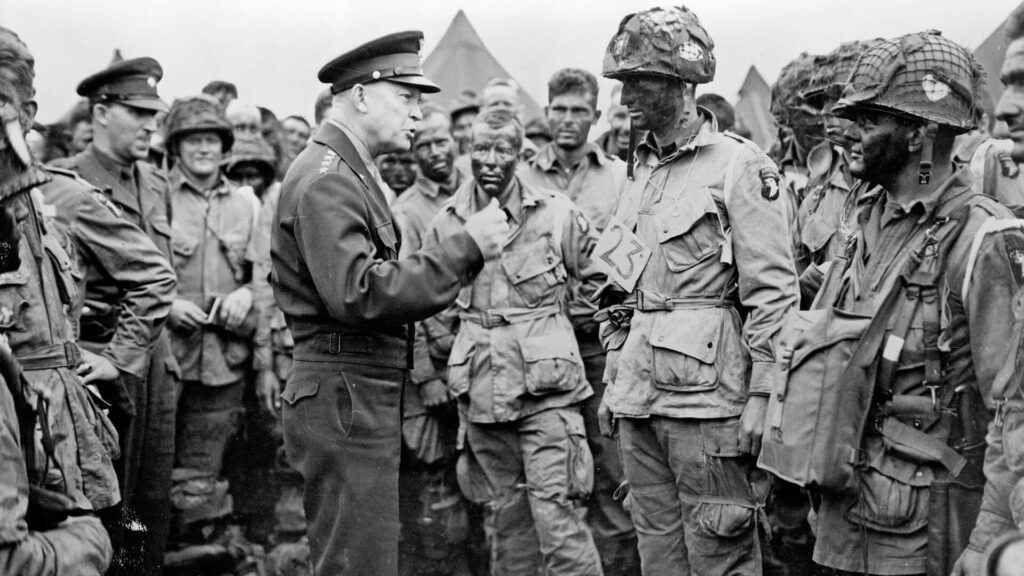By Meghan E. Gattignolo
On June 6, 1944, some 156,000 troops from the UK, Canada, and the US landed on the shores of enemy-occupied France to bravely face Nazi Germany head on. The strategy was to take out Germany first, before focusing all military strength on Japan. First, though, Allied troops had to do the impossible: breach Hitler’s heavily fortified Atlantic Wall.
Among those soldiers who showed up on the front lines on D-Day were members of the 101st Airborne Division, the Screaming Eagles.

Insignia of the 101st Airborne Division (Air Assault)
The Screaming Eagles’ “Rendezvous with Destiny”
The Screaming Eagle patch on the arm of a Ft. Campbell soldier is a familiar sight to Clarksville residents. However, the 101st was not initially based at Ft. Campbell. The Division was activated in August 1942 at Camp Claiborne. They didn’t stay there long, moving around to different installations to train, their final training location in England the year before D-Day.
The 101st Airborne Division was born specifically to fight in WWII. However, the Division’s first commander recognized that the 101st had a mighty calling with a bright future. Soon after the Division was activated, Maj. Gen. William C. Lee had some inspiring words for the soldiers who were before him preparing to train for war. He told them that although the new Division had no history, they would soon have a “rendezvous with destiny.” The Division “would be called upon to carry out operations of far-reaching military importance,” and they would defeat the enemy by “falling on them like a thunderbolt from the skies.”

General Eisenhower with the 101st Airborne Division. Photo by U.S. Army Signal Corps / US Army Military History Institute / Photo Courtesy of U.S. Army
Famous Picture
The picture of General Eisenhower addressing the 101st Airborne the night before D-Day is considered the most circulated image of Eisenhower during WWII. In the picture, Eisenhower is lending words of encouragement to the soldiers around him at Greenham Common Airfield in England at 8:30 pm on June 5, 1944, knowing full well it was likely many of the men he was speaking to would meet their death within hours.
Game Day
The Screaming Eagles were trained as paratroopers in anticipation of D-Day’s Normandy landings. Other groups of Allied forces entered France by boat, landing on the beaches of Normandy in German-occupied France. The troops storming the beaches were a threat expected by the enemy, and were sitting ducks on the water while German forces shot at them from the dunes. If the Allies survived the boats while they waited to reach dry land, they still had to make it up the sandy beaches to continue fighting. The 101st paratroopers, however, dropped into enemy territory from above.
The German army was prepared for an invasion by sea with an amalgamation of armed troops, concrete bunkers, anti-aircraft gun silos, and landmines that extended for miles along Europe’s coastline, dubbed the Atlantic Wall. The idea behind the Division’s mission was to avoid the fortifications completely – by flying over them and dropping in from behind.
The 101st were the first Allied soldiers with boots on the ground in enemy territory. After landing, many soldiers found themselves alone, not sure if anyone else made their target. An estimated 1,500 paratroopers were killed or captured upon landing. Still, the operation was successful. Germany wasn’t able to defend the beaches as well as they might have due in large part to the confusion created by attacks from behind them, and the Atlantic Wall was breached before the end of the day.

Men of the 101st Airborne Division inspect a broken glider, September 1944. Photo by US Army Signal Corps / US Army Military History Institute / Photo Courtesy of U.S. Army
Destined for Greatness
The 101st Airborne went on to fight in other important events of WWII, including the Battle of the Bulge. They played no small part in bringing the deadliest war the world has ever known to an end. The Division moved into their forever home at Ft. Campbell, KY, in the early 1950s after the Defense Department decided the post would be a permanent military installation. Although the 101st Airborne Division had “no history” before June 6, 1944, today it’s one of the most recognizable and historically relevant military divisions. The 101st remains among the first to deploy in times of conflict and has fought in every American-involved war over the last 80 years.
While you have the opportunity, come out to the Museum and see the fascinating artifacts on display in the Lobby from this incredible period in time. Pieces of WWII donated to the Museum by Army veterans are joined by a 101st Airborne paratrooper uniform on loan from Ft. Campbell’s Don F. Pratt Museum. Marking the 80th Anniversary of D-Day exhibition is open from now until July 28th. Also, don’t miss the Museum’s free screening of The Longest Day, a recreation of the Normandy landings, at 3 pm on Thursday, June 6. Then, stick around after the movie to enjoy the First Thursday Art Walk!
Resources:
https://web.archive.org/web/20131016203751/http://www.army.mil/media/11942
https://home.army.mil/campbell/units/history
https://home.army.mil/campbell/cultural-resources/history/wwii-history

Meghan E. Gattignolo is a freelance writer and longtime Clarksville, TN resident. She loves to obsess about historical subjects and annoy her family daily with unsolicited random facts. Meghan holds a History B.A. from Austin Peay State University and lives in town with her husband and two children.